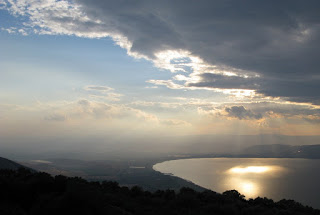[
No earlier items |
Chain Index |
Fruit of the Spirit ]
Defining joy is not easy, but it's well worth a try. It is an internal thing, yet it can have great external effects in the lives of those who have it.
One of the things I remember about church from my childhood days is that it seemed dull. Church was a chore. We had to get dressed in our best clothes, we had to be quiet, we couldn't read a book or play with toys, we had to stand up and sit down at the relevant times and say words we didn't really understand when everyone else said them. Oh, and we had to listen to a man in strange clothes talk about things that didn't engage us and that we'd soon forget.
Church even
smelled boring! The combination of ancient, polished timber, the cool humidity of the massive stonework even in the hot summer sunshine, and the leathery, musty paper of well-worn hymnbooks spelled dullness. I was always glad to get home and change into ordinary clothes. Then I could read books, ride my trike in the garden, or play with toys on the sitting room floor.
And later, as a young adult with children of my own, church was still relatively sombre and heavy. It was a serious matter and laughter was out of place except, perhaps, over a cup of tea after the service.
Where was the joy? What
is joy anyway? What good is it and why do I need it?
Joy is listed by Paul as part of the fruit of the Spirit (
Galatians 5:22-23) yet it's not something we often study. We know the importance of love and peace, of patience, kindness and the rest. But joy? It seems to be an inner thing, not affecting those around us. It's like an inner smile, a peaceful sense that all is well, a deep gratitude that Jesus has saved us. But where is the fizz, the bounce, the excitement, the celebration?
In his autobiographical book '
Surprised by Joy',
CS Lewis describes joy as an intense longing for something good. And described in those terms, surely joy is not only an inner smile, but also a sturdy force driving us to touch the hearts of others so they, too, may find joy in their inner being. Here's an extract from his preface.
How far the story matters to anyone but myself depends on the degree to which others have experienced what I call 'joy'. If it is at all common, a more detailed treatment of it than has (I believe) been attempted before may be of some use. I have been emboldened to write of it because I notice that a man seldom mentions what he had supposed to be his most idiosyncratic sensations without receiving from at least one (often more) of those present the reply, 'What! Have you felt that too? I always thought I was the only one.'
Joy is a tricky word to define. In some ways it suggests the opposite of dull and boring. The word also conveys a sort of inner energy, a hopefulness, and a patience in difficult circumstances. Yet it means more than that.
My friend Jenny, writing about anxiety in the
Stamford Free Church newsletter for April 2012, puts it like this.
Lately I have been thinking about what we mean by worry and how we use that word when we mean all kinds of different emotions and feelings. Very often, when we say that we are worried about people, especially family members, what we mean is that we feel compassionate and have empathy with their problems and difficulties ... those sort of feelings are quite legitimate and show that we care.
Jenny goes on to describe other kinds of worry caused by financial difficulty, health issues, ageing and problems with relationships. She also mentions how negative reporting by the media may make us anxious about things we cannot influence. But then she reminds us...
Jesus told his disciples many times not to worry or be afraid and that he would give them peace, so let's give all the personal 'worries' to him, let's try to make prayer our first response instead of our last and as for the other things that the media would like us to take on board - why worry?
So perhaps it's fair to say that joy is also an absence of anxiety.
For Jesus, joy is a powerful and substantial motive force that enables him to endure. See, for example,
Hebrews 12:2, 'For the joy set before him [he] endured the cross, scorning its shame, and sat down at the right hand of the throne of God.'
On the face of it, joy is a personal and private inner thing, a component of the fruit of the Spirit that is not visible externally (like the stone inside a peach). Yet it has great power, just like the stone that contains a seed capable of generating a whole new peach tree.
So joy, although it is internal, has the power to achieve much. Perhaps it's easier to say what it is
not rather than what it is. Joy is not dull or boring, it does not leave room in my heart for worry or anxiety to take root, and it strengthens me for greater endurance in love, peace, patience, kindness and the rest.
Only love comes ahead of joy in Paul's list in Galatians. And for good reason. Without love and joy the other aspects of the fruit might not even be possible. Along with peace these two are internal parts of the fruit. The other six are the active outward expression of the love, joy and peace within.
This article is part of a chain blog on 'Spiritual fruit'. If you want to write the next article in the chain please check the chain index for details.[
No earlier items |
Chain Index |
Fruit of the Spirit ]















